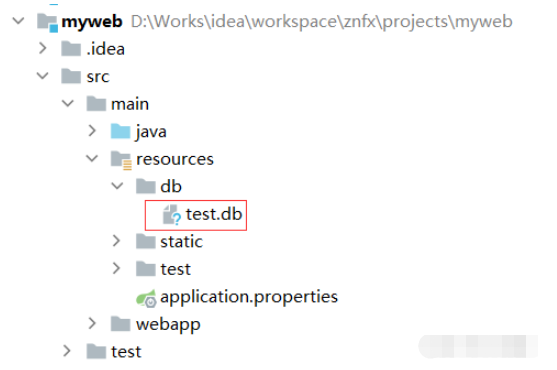这篇“SpringBoot怎么整合SQLite数据库”文章的知识点大部分人都不太理解,所以小编给大家总结了以下内容,内容详细,步骤清晰,具有一定的借鉴价值,希望大家阅读完这篇文章能有所收获,下面我们一起来看看这篇“SpringBoot怎么整合SQLite数据库”文章吧。
SQLite是一个进程内的库,实现了自给自足的、无服务器的、零配置的、事务性的 SQL 数据库引擎。它是一个零配置的数据库,这意味着与其他数据库不一样,您不需要在系统中配置。
就像其他数据库,SQLite 引擎不是一个独立的进程,可以按应用程序需求进行静态或动态连接。SQLite 直接访问其存储文件。
ACID事务
零配置 – 无需安装和管理配置
储存在单一磁盘文件中的一个完整的数据库
数据库文件可以在不同字节顺序的机器间自由的共享
支持数据库大小至2TB
足够小, 大致13万行C代码, 4.43M
比一些流行的数据库在大部分普通数据库操作要快
简单, 轻松的API
包含TCL绑定, 同时通过Wrapper支持其他语言的绑定
良好注释的源代码, 并且有着90%以上的测试覆盖率
独立: 没有额外依赖
源码完全的开源, 你可以用于任何用途, 包括出售它
支持多种开发语言,C, C++, PHP, Perl, Java, C#,Python, Ruby等
<dependencies> <!--web应用基本环境配置 --> <dependency> <groupId>org.springframework.boot</groupId> <artifactId>spring-boot-starter-web</artifactId> </dependency> <!--sqlite--> <dependency> <groupId>org.xerial</groupId> <artifactId>sqlite-jdbc</artifactId> </dependency> <!-- jdbc --> <dependency> <groupId>org.springframework.boot</groupId> <artifactId>spring-boot-starter-jdbc</artifactId> </dependency> </dependencies>
SQLite只需要关联一个.db文件,就能实现数据库的连接操作。
spring.datasource.driver-class-name=org.sqlite.JDBC #绝对位置配置方式 #spring.datasource.url=jdbc:sqlite:E:/db/test.db #相对位置配置方式 spring.datasource.url=jdbc:sqlite::resource:db/test.db
在如下位置,手动创建一个 test.db 空文件

@Autowired private JdbcTemplate jdbcTemplate;
// 1、建表 DDL
String createUser = "create table user(" +
"id integer primary key autoincrement," +
"name varchar(20)," +
"age integer" +
")";
jdbcTemplate.update(createUser);
// 2、插入数据
String insertUserData = "insert into user(name,age) values ('张三',18),('李四',20)";
jdbcTemplate.update(insertUserData);
// 3、查询语句
String selectUserData = "select * from user";
List<Map<String, Object>> list = jdbcTemplate.queryForList(selectUserData);
for (Map<String, Object> map : list) {
for (Map.Entry<String, Object> entry : map.entrySet()) {
System.out.println(entry.getKey() + "=" + entry.getValue());
}
}
// 5、删除整张表
String dropTable = "drop table user";
jdbcTemplate.update(dropTable);完整测试代码
package com.study.myweb;
import org.springframework.beans.factory.annotation.Autowired;
import org.springframework.boot.CommandLineRunner;
import org.springframework.boot.SpringApplication;
import org.springframework.boot.autoconfigure.SpringBootApplication;
import org.springframework.jdbc.core.JdbcTemplate;
import org.springframework.stereotype.Controller;
import java.util.List;
import java.util.Map;
@SpringBootApplication
public class MyWebApplication implements CommandLineRunner {
@Autowired
private JdbcTemplate jdbcTemplate;
public static void main(String[] args) {
SpringApplication.run(MyWebApplication.class, args);
}
@Override
public void run(String... args) throws Exception {
// 1、建表 DDL
String createUser = "create table user(" +
"id integer primary key autoincrement," +
"name varchar(20)," +
"age integer" +
")";
jdbcTemplate.update(createUser);
// 2、插入数据
String insertUserData = "insert into user(name,age) values ('张三',18),('李四',20)";
jdbcTemplate.update(insertUserData);
// 3、查询语句
String selectUserData = "select * from user";
List<Map<String, Object>> list = jdbcTemplate.queryForList(selectUserData);
for (Map<String, Object> map : list) {
for (Map.Entry<String, Object> entry : map.entrySet()) {
System.out.println(entry.getKey() + "=" + entry.getValue());
}
}
// 4、删除整张表
String dropTable = "drop table user";
jdbcTemplate.update(dropTable);
}
}以上就是关于“SpringBoot怎么整合SQLite数据库”这篇文章的内容,相信大家都有了一定的了解,希望小编分享的内容对大家有帮助,若想了解更多相关的知识内容,请关注亿速云行业资讯频道。
免责声明:本站发布的内容(图片、视频和文字)以原创、转载和分享为主,文章观点不代表本网站立场,如果涉及侵权请联系站长邮箱:is@yisu.com进行举报,并提供相关证据,一经查实,将立刻删除涉嫌侵权内容。